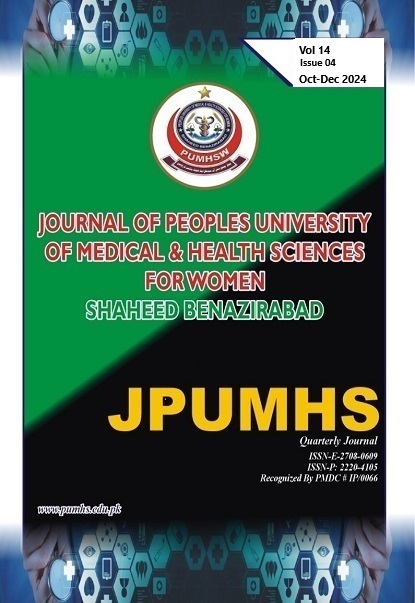EMERGENCY MANAGEMENT OF CHEST TRAUMA REQUIRING INTUBATION: CLINICAL OUTCOMES AT PUMHS NAWABSHAH.
JPUMHS;2024:14:04,116-1123.http://doi.org/10.46536/jpumhs/2024/14.04.568
Keywords:
Chest trauma, emergency intubation, time to intubation, direct laryngoscopy, video laryngoscopy, complications, mortality, survival analysis, low-resource settings, airway management.Abstract
BACKGROUND: Morbidity and mortality from chest trauma, in particular, is a major
contributor and occurs especially in low- and middle-income countries LMICs. Emergency
tracheal intubation continues to be a cornerstone of airway management for critically injured
patients, but outcomes are variable depending upon the type, timing, and complications of
intubation. This study assesses the clinical outcomes of emergency intubation in chest trauma
patients treated at PUMHS Nawabshah. METHODS: This is a cross-sectional study with
120 patients with chest trauma who need emergency intubation. Demographics, mechanisms
of injury, time to intubation, method direct vs. video laryngoscopy, complications, mortality
and hospital length of stay were noted. Chi-square tests, Kaplan-Meier survival analysis and
logistic regression were used to identify predictors of mortality. RESULTS: Male patients
made up the majority of patients 76.7% and the commonest mechanism of injury was road
traffic accidents 60%. There was a significant increase in mortality with delay to intubation,
from 5% 5–10 minutes to 16.7% >20 minutes p=0.045. Although in widespread use 75%,
direct laryngoscopy was associated with higher rates of hypoxia 20% than video
laryngoscopy. Airway trauma patients averaged 11.5 days in the hospital and complications
with hypoxia and hypotension prolonged hospital stay. Time to intubation and length of stay
were identified as significant predictors of mortality p<0.01 by logistic regression.
CONCLUSION: Chest trauma patients require timely intubation and effective airway
management to improve outcomes. There are efforts to decrease delays and operator
proficiency in advanced airway techniques to reduce complication and mortality.
Downloads
Downloads
Published
How to Cite
Issue
Section
License

This work is licensed under a Creative Commons Attribution-NoDerivatives 4.0 International License.




